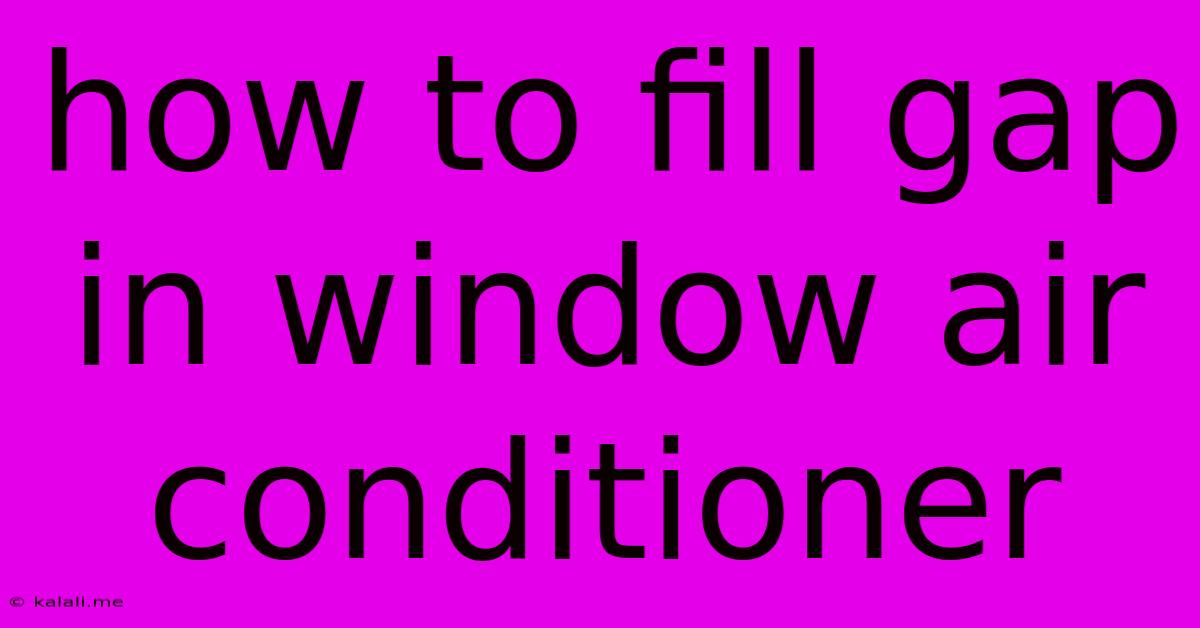How To Fill Gap In Window Air Conditioner
Kalali
Jun 01, 2025 · 3 min read

Table of Contents
How to Fill Gaps in Window Air Conditioner Installation
Summer's heat got you down? A window air conditioner can be your saving grace, but only if it's properly installed. Air leaks around your AC unit can significantly reduce its efficiency, leading to higher energy bills and a less comfortable home. This article will guide you through identifying and effectively sealing gaps in your window air conditioner installation, ensuring maximum cooling power and energy savings.
Why Sealing Gaps is Crucial
Failing to properly seal gaps around your window air conditioner leads to several problems. Hot air can easily infiltrate your cooled space, forcing your AC unit to work harder to maintain the desired temperature. This increased workload translates directly to higher electricity consumption and a shorter lifespan for your appliance. Furthermore, leaks can allow insects and dust to enter your home, compromising indoor air quality. Sealing gaps is about more than just comfort; it's about efficiency and longevity.
Identifying Gaps and Air Leaks
Before you start sealing, you need to find the culprits. Carefully examine the area where your air conditioner sits in the window. Look for gaps:
- Between the air conditioner and the window frame: This is the most common location for leaks.
- Between the window and the window sill: Check for gaps at the top, bottom, and sides of the window.
- Around the unit's edges: Inspect the seals along the unit itself for any openings.
You can often feel drafts with your hand, or use a small piece of paper to check for airflow. If the paper is easily blown away from the gap, you've found a leak that needs sealing.
Materials for Sealing Gaps
Several materials can effectively seal gaps around your window air conditioner. Choose based on the size and location of the gap:
- Foam sealant: Great for filling small to medium gaps. Expanding foam fills the space completely, creating a tight seal.
- Weatherstripping: Ideal for smaller gaps and sealing around edges. Choose weatherstripping that's durable and resistant to heat and UV damage.
- Caulk: Useful for larger gaps and filling cracks. Ensure you use a paintable caulk for a neat, finished look.
- Insulation: For larger openings, consider using expanding foam insulation in conjunction with other sealing methods.
Step-by-Step Guide to Sealing Gaps
- Clean the area: Before applying any sealant, clean the surfaces around the air conditioner thoroughly. Remove any dust, debris, or loose paint. This will ensure better adhesion.
- Apply sealant: Carefully apply your chosen sealant, following the manufacturer's instructions. For foam sealant, ensure you don't overfill the gap.
- Allow to dry: Let the sealant cure completely before using the air conditioner. Drying times vary depending on the material and environmental conditions.
- Trim excess sealant: Once dry, carefully trim any excess sealant with a sharp knife or utility blade.
- Inspect the seal: After the sealant has cured, check again for any remaining gaps or leaks.
Maintaining Your Seal Over Time
Regular inspection and maintenance are essential to ensure your window air conditioner continues to operate efficiently. Check for signs of wear and tear on the sealant and reapply as needed. This proactive approach will maximize the lifespan of your unit and keep your home cool and comfortable all summer long.
By diligently sealing those gaps, you'll enjoy a cooler, more comfortable home, save money on your energy bills, and prolong the life of your air conditioner. Remember, a well-sealed unit is a happy, efficient unit.
Latest Posts
Latest Posts
-
How To Know Head Gasket Is Blown
Jun 03, 2025
-
Is A Periodical Title A Magazine Title
Jun 03, 2025
-
Many Are Called But Few Are Chosen Meaning
Jun 03, 2025
-
How To Change Bulb On Recessed Light
Jun 03, 2025
-
Can Stainless Steel Cookware Go In The Oven
Jun 03, 2025
Related Post
Thank you for visiting our website which covers about How To Fill Gap In Window Air Conditioner . We hope the information provided has been useful to you. Feel free to contact us if you have any questions or need further assistance. See you next time and don't miss to bookmark.